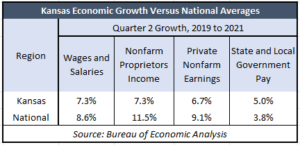In November 2021, the state of Kansas took in total tax revenue of $626.8 million, which was 3.1% greater than the estimates for this month. This includes $285.4 million in sales taxes and $302.9 million in income taxes. The revenue collected for November of this year was 12.6% higher than what it was in November of last year.
In total, the tax revenues thus far in FY 2022 are approximately $3.4 billion – roughly .6% greater than the updated budget predictions for FY 2022. Kansas’ estimates for the rest of the fiscal year include an additional $1.298 billion in total taxes collected compared to initial June 2021 predictions – that’s about 16% of the state’s General Fund spending of $8 billion.
Kansas’ increased revenue intake over the past year isn’t unique as almost every state across the country is seeing an influx of cash. Missouri currently holds more than $4 billion in unappropriated funds from the past year. Colorado alone has $3.3 billion it can spend – not to mention $2.6 billion in COVID-19 relief funds on their plate too.
States are faced with the decision of what to do with the surplus money – expand or limit the size of government. For instance, Iowa’s Taxpayer Relief Fund is projected to have an ending balance of $1.8 billion to be allocated to reduce the cost of government on taxpayers. Kansas legislators should be careful with the state’s surplus: the government should avoid either a massive spending spree or massive tax cuts without a plan to offset those costs in the future – otherwise, taxpayers will foot a bigger bill in the future.
These continually increasing higher government tax revenues are a sign of over-taxation that, in the long run, reduces consumer spending and investment by taking money out of the economy. It makes sense then that the state should reduce its tax burden to keep more money in the pockets of working families and businesses.
High tax burdens brought on by uncontrolled spending would harm Kansas’ economic growth – which is already behind the U.S. average. Whereas the national growth in wage and salaries during Quarter 2 was 8.6%, in Kansas, it was 7.3%. Kansas was also be hind in the growth of nonfarm proprietors’ income and private nonfarm earnings. However, at the same time, the pay of state and local government employees grew at a rate 1.2 percentage points higher than the national average.
hind in the growth of nonfarm proprietors’ income and private nonfarm earnings. However, at the same time, the pay of state and local government employees grew at a rate 1.2 percentage points higher than the national average.
Government expansion crowds out private businesses and slows economic growth. Instead of turning high revenue into more government, Kansas should reduce the tax burden and thus give businesses and taxpayers more opportunities to spend the money they’ve already earned.





